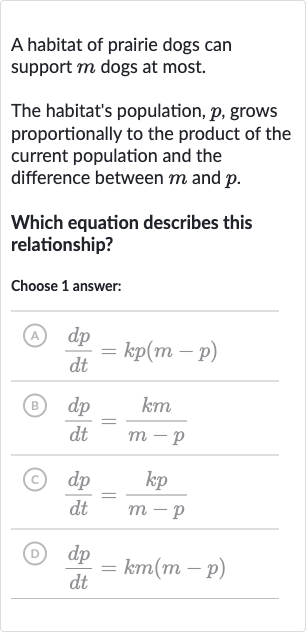AI tutor
Full solution
Q. A habitat of prairie dogs can support dogs at most.The habitat's population, , grows proportionally to the product of the current population and the difference between and .Which equation describes this relationship?Choose answer:(A) (B) (C) (D)
- Understand the problem: Understand the problem.We are given that the population of prairie dogs grows proportionally to the product of the current population and the difference between the maximum population and the current population . This is a typical differential equation problem in population dynamics.
- Identify the correct form: Identify the correct form of the equation.The growth rate of the population is given by the derivative of the population with respect to time, . Since the growth is proportional to , we expect the equation to have on the right-hand side, where is the constant of proportionality.
- Match the correct form: Match the correct form with the given options.We are looking for an equation of the form . This matches with option (A).
- Verify other options: Verify that the other options are incorrect.Option (B) has the term , which does not represent a proportional relationship between the growth rate and .Option (C) has the term , which is not the product of and .Option (D) has the term , which suggests that the growth rate is proportional to alone and does not include the current population .
More problems from Write a linear function: word problems
QuestionGet tutor help
QuestionGet tutor help
QuestionGet tutor help
QuestionGet tutor help
QuestionGet tutor help
QuestionGet tutor help
QuestionGet tutor help
QuestionGet tutor help
QuestionGet tutor help

